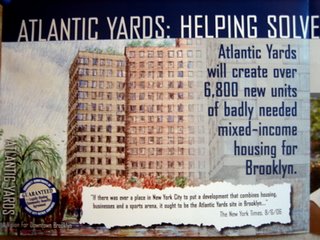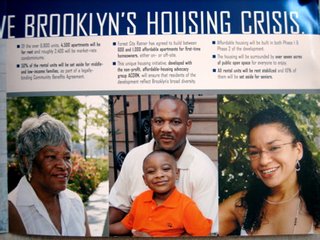So, Atlantic Yards has been analyzed through many lenses, but environmental justice is a new one. This spring, an article published in the Journal of Sport & Social Issues bore the title Sports and Environmental Justice: "Games" of Race, Place, Nostalgia, and Power in Neoliberal New York City and, while jargon-heavy, it offers some insights, notably that "the developer co-opted the racialized discourse of social movements for economic, environmental, and social justice."
The author is University of California Davis American Studies professor Julie Sze, a former Brooklynite and author of Noxious New York: The Racial Politics of Urban Health and Environmental Justice. She relied significantly on AY critics such as Daniel Goldstein of Develop Don't Destroy Brooklyn (DDDB), urban planning professor Tom Angotti, and the film Brooklyn Matters.
Sze's book concerns the impacts of polluting facilities and while an arena is not a waste transfer station, there are similarities in the development battles. The irony is that some of those who might be expected to resist the imposition on the community of an arena do not do so, because they have partnered with the developer or been co-opted.
The CBA debate
Well, what does this mean in reality? At a 6/30/04 community meeting captured for the Battle of Brooklyn documentary-in-process (donations welcome), then-Assemblyman Roger Green contends that negotiating with the developer will bring more fruits to the community than in previous development debates.
"This is a fixed poker game," responds Jim Vogel of the (yet to be formed) Council of Brooklyn Neighborhoods.
"What is this Community Benefit Agreement if not a tool to divide the community," declares Gib Veconi of the Prospect Heights Neighborhood Development Council.
Some question the lack of a democratic process. "They got a democratically-elected governor, a democratically-elected mayor, and a democratically-elected borough president to try to push this thing through," Green responds. (Unmentioned is the bypass of the City Council; City Council Member Letitia James is at the meeting but not quoted in the segment.)
"Architecture of neoliberalism"
Sze's no fan of AY:
Sports, race, and class
The money quote:
Sze notes that one scholar discerned "three faces of power in stadium siting disputes":
The discourse
Who's the winner?
Sze offers a cogent analysis of how the developer has distracted the public:
And, I'd add, by saving more than $100 million with the MTA, and getting other concessions from the ESDC, the developer has had a lot more money to spread around.
A solution?
Sze suggests that there are exceptions to the race/class divide:
The author is University of California Davis American Studies professor Julie Sze, a former Brooklynite and author of Noxious New York: The Racial Politics of Urban Health and Environmental Justice. She relied significantly on AY critics such as Daniel Goldstein of Develop Don't Destroy Brooklyn (DDDB), urban planning professor Tom Angotti, and the film Brooklyn Matters.
Sze's book concerns the impacts of polluting facilities and while an arena is not a waste transfer station, there are similarities in the development battles. The irony is that some of those who might be expected to resist the imposition on the community of an arena do not do so, because they have partnered with the developer or been co-opted.
The CBA debate
Well, what does this mean in reality? At a 6/30/04 community meeting captured for the Battle of Brooklyn documentary-in-process (donations welcome), then-Assemblyman Roger Green contends that negotiating with the developer will bring more fruits to the community than in previous development debates.
"This is a fixed poker game," responds Jim Vogel of the (yet to be formed) Council of Brooklyn Neighborhoods.
"What is this Community Benefit Agreement if not a tool to divide the community," declares Gib Veconi of the Prospect Heights Neighborhood Development Council.
Some question the lack of a democratic process. "They got a democratically-elected governor, a democratically-elected mayor, and a democratically-elected borough president to try to push this thing through," Green responds. (Unmentioned is the bypass of the City Council; City Council Member Letitia James is at the meeting but not quoted in the segment.)
"Architecture of neoliberalism"
Sze's no fan of AY:
The architecture of neoliberalism? Well, neoliberalism, as seen by left-wing scholars (like David Harvey) and activists, implies a lesser role for the state and a reliance on the private sector.The Atlantic Yards project privatizes public and open space, promotes free-market development (while heavily dependent on state subsidies and public money), and symbolically promotes the architecture of neoliberalism.
Sports, race, and class
The money quote:
In particular, the developer’s mobilization of the discourse of the environmental justice movement is significant and raises important issues about how corporate actors in neoliberal New York City use sports, race, class, and the environment in deeply troubling and fascinating ways.A fourth face of power: "racialized discourse"
Sze notes that one scholar discerned "three faces of power in stadium siting disputes":
- the public and institutional face of those in charge
- the barriers that keep certain groups out of the discourse
- and subordinate groups who accept their powerlessness
Specifically, in this campaign, the developer co-opted the racialized discourse of social movements for economic, environmental, and social justice, and in doing so, highlighted long-standing class divisions within African American communities in Brooklyn within the context of gentrification trends and antigentrification activism. The developer made alliances with fair housing and labor groups, who focused on the racial benefits of their alliance with the corporate developer, to refute the opposition to the project and control the racial discourse around the project.The analysis
By focusing on some of the early public discourse, I think Sze misses part of the story. She cites a campaign to “Bring the Nets Home to Brooklyn,” which ties to the loss of the Brooklyn Dodgers and the "proposed (and ultimately rejected)" site for a new Ebbets Field.
 While the Dodgers aimed to move across the street, it's also important to note that the developer changed the discourse to emphasize a more pressing issue for many Brooklynites: affordable housing.
While the Dodgers aimed to move across the street, it's also important to note that the developer changed the discourse to emphasize a more pressing issue for many Brooklynites: affordable housing.
Sze argues that this development differs from others in New York City because of "its dependence on basketball to make the case," citing arena critic Bob Law from Brooklyn Matters. Again, however, Forest City Ratner has changed its rhetoric.
 While the Dodgers aimed to move across the street, it's also important to note that the developer changed the discourse to emphasize a more pressing issue for many Brooklynites: affordable housing.
While the Dodgers aimed to move across the street, it's also important to note that the developer changed the discourse to emphasize a more pressing issue for many Brooklynites: affordable housing.Sze argues that this development differs from others in New York City because of "its dependence on basketball to make the case," citing arena critic Bob Law from Brooklyn Matters. Again, however, Forest City Ratner has changed its rhetoric.
The discourse
While I doubt they did so in the name of environmental justice, several people--as Sze suggests--raised "environmental justice topics, issues, and symbols" during the 8/23/06 public hearing held by the Empire State Development Corporation (ESDC). City Council Member Letitia (not Leticia) James referred to a seven-year-old girl who had died of asthma, and got booed by project supporters.

Project supporter Darnell Canada, warned, in words more ominous than Sze portrays, “You all talking ‘bout save the environment, better save yourself. Better make sure this process go through, cause I’m telling you if it don’t, you the victim."

Project supporter Darnell Canada, warned, in words more ominous than Sze portrays, “You all talking ‘bout save the environment, better save yourself. Better make sure this process go through, cause I’m telling you if it don’t, you the victim."
Who's the winner?
Sze offers a cogent analysis of how the developer has distracted the public:
Although the primary beneficiary of the project is Ratner, the developer rhetorically, symbolically, and pragmatically widened the “we” to include labor and housing groups through the Community Benefits Agreement [CBA], and the “public” and borough writ large, with the focus on sports (the Nets) and recreation (“Urban Room” and green space). Thus, the public hearing was a performance of Ratner’s proxies.So have a lot of public hearings; also note that Forest City Ratner did not offer its own representatives, just CBA representatives, to speak to the press at the October 14 eminent domain hearing.
And, I'd add, by saving more than $100 million with the MTA, and getting other concessions from the ESDC, the developer has had a lot more money to spread around.
A solution?
Sze suggests that there are exceptions to the race/class divide:
For example, activist groups like Families United for Racial and Economic Equality (FUREE), which has organized against the Downtown Brooklyn plan since 2003, also uses a racialized (and gendered) framework as the basis for their analysis. But where Holt and Canada use the racial discourse of Black rage at gentrification to exploit class differences (and to render invisible their own co-optation by the developer), FUREE uses their racialized analysis to encompass other non-Black working people under its umbrella. Although they have not focused specifically on Atlantic Yards, their focus on multiracial communities of color, particularly women of color, reveals how an intersectional race- and class-sensitive analysis of urban development can avoid the co-optation in the Atlantic Yards case.
I'm not sure what to make of that. Could FUREE have more effectively opposed AY than Develop Don't Destroy Brooklyn (DDDB)? I doubt that.
Could DDDB have done better at outreach? Yes, DDDB's Daniel Goldstein acknowledges that the opposition could be more diverse, but, then again, the CBA signatories have never held a public meeting. Should DDDB have spent some money not on lawyers but community organizers? Tough question.
Lessons
Sze suggests that
Could DDDB have done better at outreach? Yes, DDDB's Daniel Goldstein acknowledges that the opposition could be more diverse, but, then again, the CBA signatories have never held a public meeting. Should DDDB have spent some money not on lawyers but community organizers? Tough question.
Lessons
Sze suggests that
environmental justice scholars and scholars of stadium siting need to be particularly sensitive to how complex and competing factors shape contemporary stadium development, including race and class stratification (and how they sometimes conflict), and the interplay of the past and the present.Um, yes.
Comments
Post a Comment